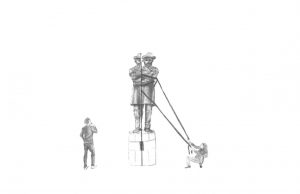Yes
The following viewpoint reflects the opinion of the author
November 9, 2017
With statues of Confederate generals such as Robert E. Lee being relocated from public spaces to museums and protests-turned-riots breaking out in their wake, the question of keeping or relocating these statues has come to the forefront of today’s political discourse. While these statues ought to be relocated from public landmark sights to the contextual and didactic environment of museums, one must first understand the context of their construction.
The majority of statues glorifying the Civil War and Confederate generals in the American South were constructed in the late 1800’s, after the end of the war and Reconstruction. They were built in a fervour now called “the Cult of the Lost Cause,” which actively sought to rewrite the narrative of American history. Its proponents argued that the war was a heroic one for the Confederates, that they were not rebels defending an inhumane institution, but rather loyal soldiers and generals who sought to protect Southern ideals, people, and rights from Northern oppression.
Republican advocates for preserving the statues point out that the majority of Southerners did not own slaves as proof that slavery was not the focus of the war, instead suggesting it was an issue of preserving Southern autonomy and states’ rights; this is an oversimplification.
Despite that one statistic, it is a general historical consensus that the Southern economy was wholly dependent on slave labor, for both tobacco and cotton. In 1861 Vice President of the Confederacy Alexander Stephens explained, “[the Confederacy]’s cornerstone lies upon the great truth that the negro is not equal to the white man. That slavery is his natural and normal condition.”
To claim that any general including Robert E. Lee was not defending slavery would be counterfactual. Robert E. Lee and his comrades all owned slaves, and were well aware of the fact that their war was one that sought to protect slavery. These generals, regardless of their personal morals, fought to preserve the short-lived Confederacy and its slave-based economy. Thus the moral narrative that these statues embody is one of revisionist history.
These statues erase the history of people of color in the South. While streets are laden with statues of these generals and men who fought for a cause of oppression, their glorification and commemoration gives little mention to the 15 million slaves who died in the Slave Trade and the antebellum plantations. Regardless of the personal opinions of any of the people displayed, they did not choose to have their statues built; they were made by “Lost Causers” who specifically sought to rewrite the history of the South to ignore its atrocities and paint an elegiac light on the Confederacy.
In the words of New Orleans Mayor Mitch Landrieu, who oversaw the removal of a statue of General Lee in May, “These statues are not just stone and metal. They are not just innocent remembrances of a benign history. These monuments purposefully celebrate a fictional, sanitized Confederacy; ignoring the death, ignoring the enslavement, and the terror that it actually stood for.”
By existing on display as monuments in the public eye, these statues demonstrate both approval and glorification of their narrative, which is one of whitewashing and a willful ignorance of the suffering of millions of African Americans for which these men fought and on which they relied.
Yet these statues’ racist histories do not diminish their historical significance. As is planned for the Jefferson Davis monument formerly in New Orleans, the Confederate statues should be relocated to museums, where they can be displayed alongside the full context of the underrepresented darker side of the Civil War and the South, and understood as pieces of ideological propaganda from the “Lost Cause” movement. These statues are historically important and worthy of remembrance; however, we should move on from the bygone era when public endorsement of white supremacy was acceptable. The Confederate statues belong in museums, not public parks.

